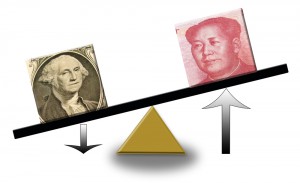 There are multi-faceted issues concerning the Chinese currency playing themselves out in the international press at this time; many of these issues will have serious ramifications for the entire world. The overarching goal the Chinese have is to make the yuan fully convertible on the international FX market. This would allow the yuan to be included in the IMF special drawing rights (SDR) along with other reserve currencies such as the dollar, pound, and euro. The Chinese intend to make the yuan fully convertible by the end of the currency calendar year.
There are multi-faceted issues concerning the Chinese currency playing themselves out in the international press at this time; many of these issues will have serious ramifications for the entire world. The overarching goal the Chinese have is to make the yuan fully convertible on the international FX market. This would allow the yuan to be included in the IMF special drawing rights (SDR) along with other reserve currencies such as the dollar, pound, and euro. The Chinese intend to make the yuan fully convertible by the end of the currency calendar year.
HONG KONG (MarketWatch) — China is expected to launch a slate of major policies “very soon” to open its capital account and make the yuan USDCNY, -0.0032%USDCNH, +0.0161% a fully convertible currency by the end of this year, the country’s largest state-controlled investment bank said in a report Tuesday.
Achieving reserve currency status for their currency is part of the Chinese plan to become a major economic player on the global stage. The Chinese realize that with economic prosperity and stability comes economic, and also, military power. The Chinese crave a power projection capability to influence world events in their favor. Having a reserve currency is critical to their making the twenty-first century a Chinese century. Beijing has made several reforms recently to allow the yuan to be up for consideration in the International Monetary Fund’s five year review for inclusion in the SDR basket.
For decades China has followed a path of growth through exports, driven by cheap labor and an undervalued currency. However, this model seems to have reached its limits. With world growth slowing, labor competition, and a resulting slowing economy, the People’s Republic is having to look inwards towards consumer spending to power the high single-digit annual expansion the country needs to satisfy its population. The unabated infrastructure spending and construction has produced numerous ghost cities across the mainland. This is obviously unsustainable and a misallocation of capital.
The Communist Party leaders are caught between a rock and a hard place. The economic model of the past has created massive bubbles in real estate and credit. China’s leaders know they have to find new ways to generate growth but also have to reduce the risk to their economy that these bubbles have created. Internal consumer growth has yet to pick up the slack of slowing exports. China’s central bank seems to have resorted recently to quantitative easing in order to maintain the competitiveness of their currency while also stimulating growth. As with the West, QE can be a short-term sugar-high but unlikely to be a solution in the long-run.
Meanwhile, a debate rages in the United States Congress over whether to punish China for currency manipulation. On the other hand, President Obama is keen to conclude the Trans-Pacific Partnership, or TPP, agreement for free trade in the Asian region. It remains to be seen what effect this agreement will have on the Chinese situation. Democrats in Congress have prevented giving Obama fast-track authority on the deal, preferring to pander to their union special interests.
As you can see, many issues are swirling around China. It seems that as a minimum China has to increase its transparency on the yuan to satisfy the Western financial world. China also has to solve the problem of its economic growth model for the future. The world waits to see if the Chinese currency becomes another reserve currency worthy of investor trust; or, does the Chinese bubble finally pop and expose the last few decades of Chinese growth for what is was, a house of cards.
LTodd Wood is a former emerging market debt trader with 18 years of Wall Street and international experience. He is also an author of historical fiction thriller novels. His first of several books, Currency, deals with the consequences of overwhelming sovereign debt. He is a contributor to Fox Business, Newsmax TV, and others. LToddWood.com





